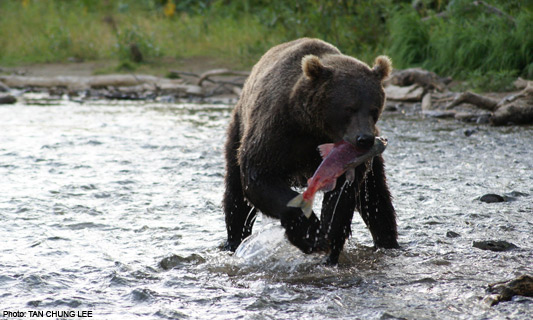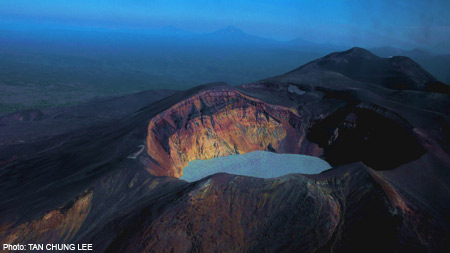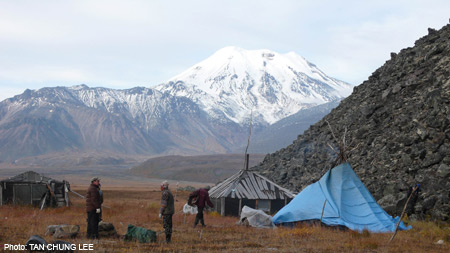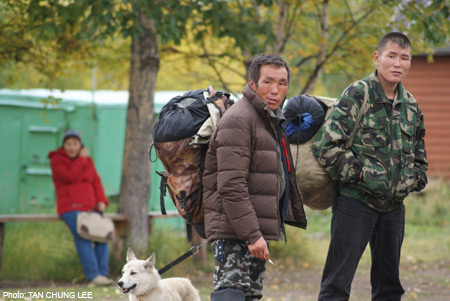Shotgun-toting wardens escort visitors around in Kamchatka in the Russian Far East, home to bears, reindeer and volcanoes.
(left: A bear catching salmon on Lake Kurilskoye located in the Kamchatka peninsula in the Russian Far East.) The sight of a rump can cause much excitement, even more so when it belongs to a giant brown bear. I had been wading thigh-deep with nine others, including a national park warden, Vasily, who had a shotgun slung across his shoulders, in the cold waters of Lake Kurilskoye and was approaching the mouth of a river when we saw a huge dark rump. It could only mean one thing - a brown bear, our first sighting in the Kamchatka peninsula in the Russian Far East, known for volcanoes and bears. We scrambled ashore for a closer look and soon saw another bear with a light blonde coat, accompanied, to our delight, by three cubs. Ten minutes later, an even larger bear than the first two showed up. All the bears were attracted to the river by one thing - salmon, which we could see writhing in thick waves in the clear waters.
It was August, the end of summer and the peak of the salmon-spawning season. The sighting of Kamchatka's brown bears was almost guaranteed. Salmon are born in rivers but swim out to live in lakes and seas. Upon reaching maturity three years later, they make their way back to the same river where they were born, to spawn. As they journey inland, the fish become targets for bears, which feed on them in a frenzy. We soon saw this in action. Bear No. 1, which like the others had been stalking the banks of the river, plunged into the water at lightning speed despite its hefty 400kg body weight. With a sharp-clawed paw, it caught a fish, scooped it up with its teeth and hurried out of the river to a sand bank. Quickly it began to eat the flesh of the fish bit by bit after stripping it off the skeletal spine. Bear No. 2, the blondie, turns up to chase away Bear No. 1 and then guards the half-eaten fish as a meal for her cubs. The entire drama unfolded just metres away from our vantage point on a sandy beach. We were to witness this bear fishing and feeding frenzy regularly over a four-day stay at Lake Kurilskoye. The lake, created out of a volcanic eruption over 8,000 years ago, is the second largest of Kamchatka's 100,000 lakes and is the biggest spawning ground for numerous varieties of red salmon. Little wonder it is also home to a substantial population of Kamchatka's estimated 12,000 brown bears. It was easy to see why the bears love to come here. As part of the Yuzhno-Kamchatsky Reserve, the lake area is completely uninhabited and two armed national park wardens are present throughout the year to keep out bear hunters and poachers. With three million salmon descending on Lake Kurilskoye every summer, the bears need never go hungry. Outside the salmon-spawning season, they feed on the numerous varieties of berries growing on the grassy tundra surrounding the scenic lake. Like most places in Kamchatka, Lake Kurilskoye is remote, accessible only by a 20-passenger Mi-8 helicopter. But it is worth the 90-minute to two-hour flight to get there. Accommodation is in a wooden lodge, Grassy Point, overlooking the lake. The bears are so at home in this area that we saw them wandering around the shores of the lake below our lodge and even behind it. For this reason, we were escorted everywhere by the wardens with shotguns and were warned never to venture out of the cabins at night. One Japanese photographer was killed because he insisted on sleeping in a tent outside to get shots of the bears. His memorial is just in front of the lodge where he had his tent. As adventure destinations go, few come close to the rugged Kamchatka peninsula. Apart from brown bears, the peninsula is home to moose, wolves, foxes and other wildlife. It is also famous for its volcanoes: There are more than 200 of them. Although 29 are active, many are smoking as well. Kamchatka is one of the most seismically active of the regions on the Pacific Rim of Fire. Covered with primaeval forests and sparsely inhabited with a density of less than one person for every square kilometre in an area twice the size of Great Britain, it is one of the world's last wildernesses. The 1,000km-long peninsula dangles down into the Pacific Ocean, separated from Alaska by the Bering Sea. Before the Russian Cossacks arrived and occupied Kamchatka in the 17th century, the peninsula was home to independent tribes. Resistance against the Russians led to frequent battles and although some of the tribes such as the Evens, Koryaks, Itelmen and Chukchis have survived, their numbers are small, making up less than 5 per cent of Kamchatka's 380,000 population. Yet the tribes have managed to retain many traditions and customs. Their existence adds an interesting cultural element to a visit in the peninsula. For a long time, Kamchatka was outside the radar of Moscow because it was considered too far away, necessitating six months of travel. Even today, it is a nine-hour flight away. But in the Soviet era, it took on a significant role as the naval base of Russia's Pacific fleet due to its strategic position. No one was allowed to visit, not even non-resident Russians. So when it was open to the world in the 1990s, it quickly became a magnet for adventure seekers. Apart from bears, other highlights of Kamchatka include its volcanoes, spouting geysers, hot springs and the chance to visit one of the last remaining Evens reindeer herder camps.
(left: A view from the air of the crater lake of Maly Semyachik.) For volcanoes, there is a dizzying choice of where to go as each one is different. On our way back from Lake Kurilskoye, for instance, we landed on the crater rim of the Ksudach volcano to walk around its enormous lake. Fifteen minutes away by helicopter (about US$250 or S$374 an hour for each person) was Khodutka volcano, beneath which 45 deg C thermal waters flow out to form the Khodutka river and a natural hot spring for swimming. Central Kamchatka offers the greatest variety of volcano gazing, thanks to the Klyuchevskaya group of volcanoes, ranging from the highest, Klyuchevskaya sopka (4,750m), to three unnamed new volcanoes created by a 1975 eruption. The main draw of the 12 active volcanoes here are the twin volcanoes of Tolbachik. Getting to central Kamchatka involved travelling 650km over a non-existent road in a 6WD Russian army truck, the only means to travel in the wilderness. The only paved road leading from the capital, Petropavlovsk-Kamchatsky, ends very quickly in the forest. But the rough two-day journey, which required a river ferry crossing and an overnight stop in a remote settlement, had its moments. Whenever we stopped in the forest to collect wood from fallen trees for our campfires, we were greeted with the rich colours of autumn as the leaves of the larch and birch trees had turned a golden pale yellow. The forest was fragrant with the pine-like scent of juniper. Its whitishgreen berries, used to make gin, were bitter. But all around us were other edible berries: red ligon berries, purple honeysuckle berries and blueberries. No wonder bears snack on them. Our arrival in Tolbachik was signalled by the thinning out of the forest and the widening of a valley, covered with lava. This is the Tolbachinsky Valley, a wondrous region of black lava fields studded with cinder cones, lava tubes and volcanic "bombs" thrown out from no fewer than 60 volcanic explosions in the last 10,000 years. Trekking up to a high ridge to view a volcanic crater created from a 1940 eruption, we enjoyed a magnificent view of about 400 cones of various shapes and sizes crowding the valley. Tolbachik consists of two peaks - the table-top Plosky (Flat) Tolbachik, rising up to 3,085m and the snowcovered Ostry (Sharp) Tolbachik, just a few metres lower. Plosky Tolbachik is the most active, with recent eruptions from 1967 to 1970 and again from 1975 to 1976. By all accounts and as seen in photos taken by volcanologists, the last eruption was the most spectacular, with fire and lava spewing out for up to a year. The devastation was so great that it destroyed 1,000 sq km of surrounding forest, blanketing it in ash and cinder 10m high. The "dead forest" of trees can be seen with petrified trunks and branches sticking out of volcanic ash. Indeed, the flow of lava was so phenomenal that lava tubes, big enough for a person to walk through, were created. There are even underground grottoes with ceilings that looked as if they had stalactites with little pins of lava coming down from them. After 30 years, the forest is beginning to renew itself with the sprouting of new vegetation, mainly larch and willow saplings. The result of Tolbachik's intense volcanism is a craggy lunar-like landscape, which led the Soviets to test their moonwalker vehicles here as part of their space programme. In fact, our base camp at the foothills of the volcanoes, where volcanologists had built some huts during their stay to study the 1975-1976 eruption in the area, is named Lunakhodchikov Station, after the Lunokhod moonwalker vehicle. The volcanoes here are still active. The authorities inform local tour operators when they are safe for visitors. On our hike up to view the three new craters created in 1975, we saw steam rising from cracks and crevices on the slopes with many of the rocks still warm to the touch. We could even set paper alight by placing it over smouldering vents.
(left: Reindeer herders camping at the base of Ichinsky volcano. Reindeer Dubbed Kamchatka's Switzerland because of its alpine character, Esso is home to 2,000 people, a quarter of whom are Evens, who have managed to preserve their storytelling traditions and dances. The Evens people's reindeer herding traditions remain intact. A visit by helicopter to a remote reindeer camp at the base of Ichinsky volcano to watch a group of Evens herders rounding up reindeer on horseback was the highlight of our visit. In their nomadic days, the Evens people would rely on their reindeer for clothing, food and shelter. Nowadays, the reindeer are raised for their meat and antlers, which are sold abroad. The Evens herders are men who live for months in the mountains with their herds, while their families live in Esso for the children to go to school. However, during school vacation, many of the youngsters take to the tundra to keep in touch with their ancestral lifestyle. GETTING THERE Fly to Vladivostok from Seoul on Korean Air or Vladivostok Air. There are no direct flights from Singapore. A round-trip costs about US$2,000 (S$2,776). To book domestic Russian flights, I contacted a travel agent in Vladivostok, Lucky Tour on +7-4232-449-944 (vladivostok@luckytour.com).
5 things to do 1. As individual travel is difficult in Kamchatka, contact a tour operator to put together an itinerary to suit your interests. The operator is useful for issuing an invitation letter to apply for a Russian entry visa, getting special permits (needed for most places) and arranging connecting helicopter flights. I used the services of Lost World (www.travelkamchatka.com, tel: +7-4152-481-852), paying about €4,000 (S$8,000), all inclusive. 2. Be patient. With many trips relying on helicopters, which are dependent on the weather, flights are often delayed and sometimes cancelled. 3. Try Kamchatka's seafood specialities, especially king crab, scallops, sea whelk, wild salmon and caviar, as well as many varieties of wild mushrooms. 4. Visit Kamchatka's famous fish market in Komsomol Square in the capital Petropavlovsk-Kamchatsky, where you can buy smoked wild salmon (140 roubles or S$6.50, for a whole fillet) and fresh salmon caviar (170 roubles for a tub). 5. Bring warm clothing. Kamchatka is often cold even in summer, with temperatures ranging from 4 to 15 deg C. 2 don'ts 1. Don't venture into the wilds alone as brown bears are present almost everywhere in Kamchatka and they are more likely to attack individuals. Be with a group wherever possible. 2. Don't forget to bring a camera with a zoom lens of at least 200mm. You will need it to photograph the brown bears, even if they are sometimes less than 10m away.
|


 On our return to the capital, we spent a couple of days at Esso, (pronounced "essa"), one of the few settlements in central Kamchatka with an ethnic Evens population. It is an idyllic village of hot springs and wooden houses with well-kept gardens.
On our return to the capital, we spent a couple of days at Esso, (pronounced "essa"), one of the few settlements in central Kamchatka with an ethnic Evens population. It is an idyllic village of hot springs and wooden houses with well-kept gardens. (left: Evens herders who raise reindeer for their meat and antlers.
(left: Evens herders who raise reindeer for their meat and antlers.